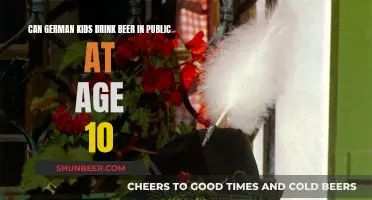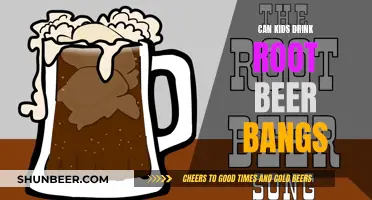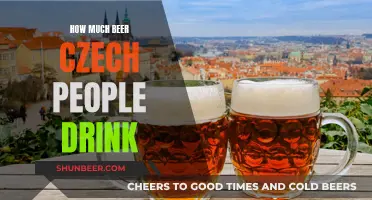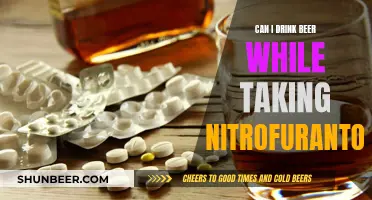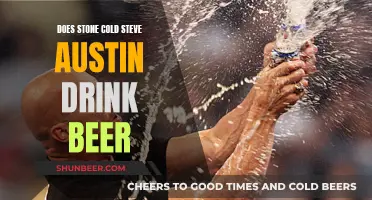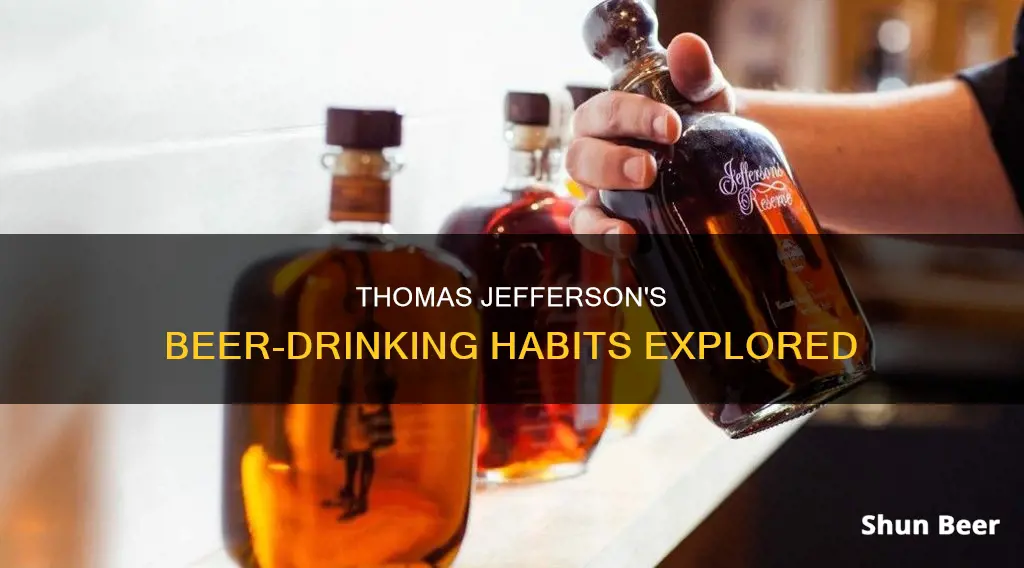
Thomas Jefferson, one of America's founding fathers, had a varied cellar and was a lover of wine, drinking three glasses of champagne in a single toast during Lafayette's retirement party. He also wrote about beer, saying: Beer, if drunk in moderation, softens the temper, cheers the spirit, and promotes health. However, it was not Jefferson who brewed beer at Monticello, but one of his slaves, Peter Hemings, a talented chef and brewer. Hemings was trained in the arts of malting and brewing by Captain Joseph Miller, a master brewer, in 1813.
What You'll Learn
- Thomas Jefferson's Monticello plantation served beer as a table liquor
- Jefferson's earliest designs for his plantation included spaces for brewing and storing beer
- Jefferson's wife Martha brewed 15-gallon batches of small beer
- Jefferson's favourite drink was wine, not beer
- Jefferson's slave Peter Hemings was the real brewmaster at Monticello

Thomas Jefferson's Monticello plantation served beer as a table liquor
Jefferson's wife Martha brewed 15-gallon batches of small beer nearly every two weeks in the early years of their marriage. Jefferson's early plans for Monticello's offices included a brewing room and a beer cellar. While travelling, Jefferson bought beer at taverns and stocked up on beer by the gallon or cask once he arrived in a city. Beer and cider were the "table drinks" at Monticello.
In 1813, Jefferson and Joseph Miller, an Englishman stranded in Albemarle County, came together for the purpose of brewing beer at Monticello. Under Miller's direction, Jefferson became "a brewer for family use". During the fall of 1813, Miller instructed the enslaved Peter Hemings, who was proficient in French cookery, in the art of malting and brewing. By the fall of 1814, there was a brewhouse at Monticello, and Jefferson had begun malting his own grain.
Peter Hemings, with several years of experience, came into his own as a maltster and brewer, and may have taught these trades to other enslaved men in Virginia. In 1820, Jefferson wrote to James Madison, stating that their "brewing for the use of the present year" was over, and that they would "malt and brew three, 60-gallon casks successively" in the fall, which would "give so many successive lessons" to anyone Madison wished to send.
After Jefferson's death in 1826, Hemings was purchased by one of Jefferson's relatives and eventually given his freedom. He worked as a tailor in Charlottesville and died sometime after 1834.
Texas Beer Laws: Drinking and Driving Explained
You may want to see also

Jefferson's earliest designs for his plantation included spaces for brewing and storing beer
Thomas Jefferson's earliest plans for his plantation at Monticello included spaces for brewing and storing beer. Beer was a "table liquor" at Monticello, where it was served during dinner. In the early years of his marriage, Jefferson's wife, Martha, brewed fifteen-gallon batches of small beer nearly every two weeks. As such, Jefferson may have wanted to expand production by including a brewing room and a beer cellar in his plantation's offices, where household services were carried out.
Jefferson's interest in brewing beer may have been sparked by his correspondence with Michael Krafft, a young author who wrote to him in 1804. Krafft requested to dedicate his book, "American Distiller", to Jefferson, which the latter agreed to. Jefferson endorsed the subject of Krafft's study, expressing his satisfaction in seeing science being applied to the "useful purposes of life". He went on to purchase Michael Combrune's "Theory and Practice of Brewing", which introduced a scientific approach to the malting and brewing processes.
In the spring of 1812, while tensions grew between the United States and Great Britain, Jefferson, retired from public life at Monticello, embarked on brewing beer. He used malt purchased from his neighbour, William Meriwether, and locally bought hops. On May 12, 1812, he instructed his overseer to "bottle the beer". This was the first brewing attempt at Monticello since his wife's brewing endeavours forty years prior.
Jefferson's brewing pursuits at Monticello were influenced by Captain Joseph Miller, a former London-based brewer and maltster, who was stranded in Albemarle County during the War of 1812. Miller trained Peter Hemings, an enslaved man who was proficient in French cookery, in the arts of malting and brewing. Hemings went on to become a master brewer at Monticello, experimenting with different ingredients such as malt made from corn.
The Best Beer to Drink: A Comprehensive Guide
You may want to see also

Jefferson's wife Martha brewed 15-gallon batches of small beer
Thomas Jefferson's wife, Martha, brewed 15-gallon batches of small beer nearly every two weeks during the early years of their marriage. Small beer has a relatively low alcohol content. In her first year of marriage, Martha produced 640 litres of beer.
Beer was a "table liquor" at Monticello, and Jefferson's earliest designs for his plantation included spaces for brewing and the storage of beer. In the early years of their marriage, Jefferson and Martha would have been brewing beer in their kitchen for their own use.
In 1812, Jefferson himself began brewing beer at Monticello, using malt purchased from his neighbour, William Meriwether, and hops bought locally. This was the first brewing attempt at Monticello since Martha had brewed beer some forty years earlier.
In addition to brewing beer, Martha knew how to make candles, soap, butter, and remedies for illnesses. She maintained a collection of notes regarding her household duties and recipes, including instructions for butchering and curing meat, and the creation of large batches of soft and hard soap, candles, and beer.
Beer and Driving: Is One Beer Too Many?
You may want to see also

Jefferson's favourite drink was wine, not beer
Thomas Jefferson's favourite drink was wine, not beer. While beer was a "table liquor" at Monticello, Jefferson's preferred tipple was wine. In fact, he was a veritable evangelist for wine, believing it promoted moderation. He wrote in a letter: "No nation is drunken where wine is cheap."
In his youth, "wine" in colonial Virginia meant a sweet dessert wine drunk after dinner, not with it. It was only during his years as American minister in Paris that he came to appreciate dry dinner wines. Returning to America, he continued to drink the dry wines, establishing at his table the rule that "you drink as you please, and converse at your ease".
Jefferson never liked liquor or brandy, and kept old Antigua rum only for his servants. He was moderate in his consumption, saying "my measure is a sober one of three or four glasses at dinner, and not a drop at any other time". He also urged government officials, including Hamilton, Monroe, Washington and Gallatin, to lower wine taxes to encourage drinking of wine in place of intoxicating liquors such as rum and whiskey.
Jefferson attributed his longevity (he died at 83) to moderate wine drinking and light eating of a mostly vegetarian diet, especially in his later years. He liked meat mainly to flavour his vegetables, and one of his canons for a happy life was that one rarely regretted eating too little.
While Jefferson did brew beer, it was his slave, Peter Hemings, who was the real brewmaster at Monticello. Hemings was a talented chef and brewer, and was likely the first Black person in America to be professionally trained as a brewer.
Alcohol and Radiation Therapy: What You Need to Know
You may want to see also

Jefferson's slave Peter Hemings was the real brewmaster at Monticello
Thomas Jefferson was a wine enthusiast who, in his later years, took an interest in brewing beer. However, it was not Jefferson who was the brewmaster at Monticello, but one of his slaves, Peter Hemings.
Peter Hemings was the son of Elizabeth Hemings, an enslaved woman owned by Jefferson's father-in-law, John Wayles. In 1774, Jefferson inherited Hemings from Wayles's estate. Hemings grew up on the Monticello mountaintop and married Betsey, an enslaved woman owned by Jefferson's son-in-law, Thomas Mann Randolph. The couple had at least five children.
Hemings initially worked as a cook at Monticello, succeeding his older brother James Hemings in this role in 1796. James had travelled with Jefferson to Paris, where he learned French cookery, and passed on these skills to his brother. Peter Hemings served as Monticello's main chef until 1809.
In the fall of 1813, Hemings learned brewing and malting from Captain Joseph Miller, a master brewer trained in England. Jefferson wrote that Miller had "benefited from instruction to one of my people by an English brewer of the first order". Hemings was likely the first Black person in America to receive professional brewing training.
Hemings's brewing skills were highly regarded. In 1815, Jefferson wrote to Miller that "our brewing of the last autumn is generally good, although not as rich as that of the preceding year, the batch which Peter Hemings did for Mr Bankhead was good". Hemings also experimented with brewing corn beer, which Jefferson served to guests in silver tumblers.
After Jefferson's death in 1826, Hemings was purchased by one of Jefferson's relatives for $1 and was eventually granted his freedom. He worked as a tailor in Charlottesville and died sometime after 1834.
Hemings's story highlights the complicated legacy of Thomas Jefferson, a founding father of the United States who also owned hundreds of slaves. Historians and breweries, such as Avery Brewing in Colorado, are now working to give Hemings the credit and recognition he deserves as one of America's pioneering craft brewers.
Drinking Beer and Playing Saxophone: A Harmful Combo?
You may want to see also
Frequently asked questions
Yes, Thomas Jefferson drank beer. Beer was a table liquor served during dinner at Monticello, and Jefferson also drank beer when travelling.
While Thomas Jefferson did conduct research and write about brewing, it was one of his slaves, Peter Hemings, who was the real brewmaster at Monticello.
Thomas Jefferson was a wine enthusiast. He had a varied cellar and knew and drank nearly all the great wines. He also wrote many times to his political contemporaries urging the government to lower wine taxes to encourage drinking of wine in place of intoxicating liquors such as rum and whiskey.
No, Jefferson was a moderate drinker. He once said, "my measure is a sober one of three or four glasses at dinner, and not a drop at any other time."


